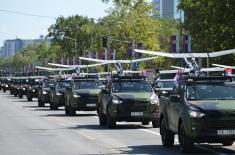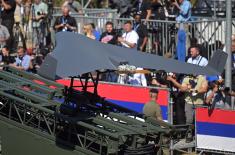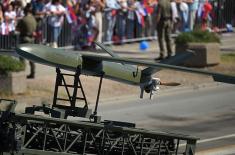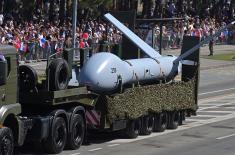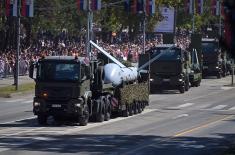Sub-Echelon of UAV/UGV Systems
The sub-echelon of UAV/UGV units consists of MILOŠ-N unmanned armed platforms, CH-95, CH-92, PEGASUS, “Vrabac“, IKA-20, and “Komarac-2“ unmanned aerial vehicles (UAVs), as well as SHADOW-25, SHADOW-50, and SM 1 and 2 loitering munitions systems.
The sub-echelon is headed by Lieutenant Colonel Vladan Nešić.
MILOŠ-N
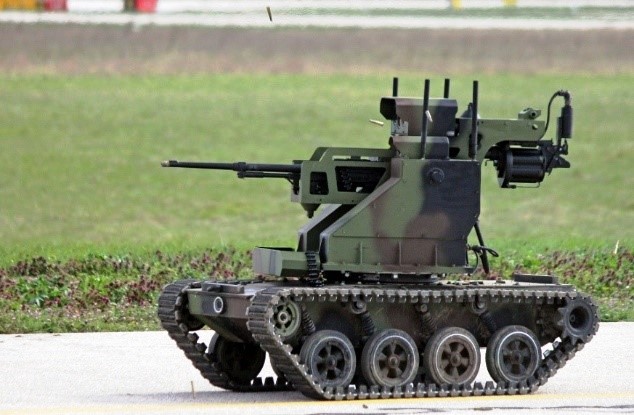
The MILOŠ-N unmanned ground combat platform is a remotely controlled small tracked armoured vehicle designed to support special forces and reconnaissance units, particularly during special operations in urban environments, including operations inside buildings. It is equipped with an optoelectronic observation and targeting system that includes a day camera, thermal imaging camera, laser rangefinder, and an auxiliary camera for horizontal surveillance. The vehicle is armed with a remotely operated weapon station featuring a 7.62 mm machine gun and a 40 mm grenade launcher, as well as an anti-tank rocket launcher (64 mm M-80) in the V-1 variant, and a 12.7 mm machine gun in the V-2 variant. This armament enables the neutralization and destruction of targets at distances of up to 800 metres. Precise vehicle movement is controlled via two day/night cameras, with a maximum speed of up to 7 km/h.
CH-95
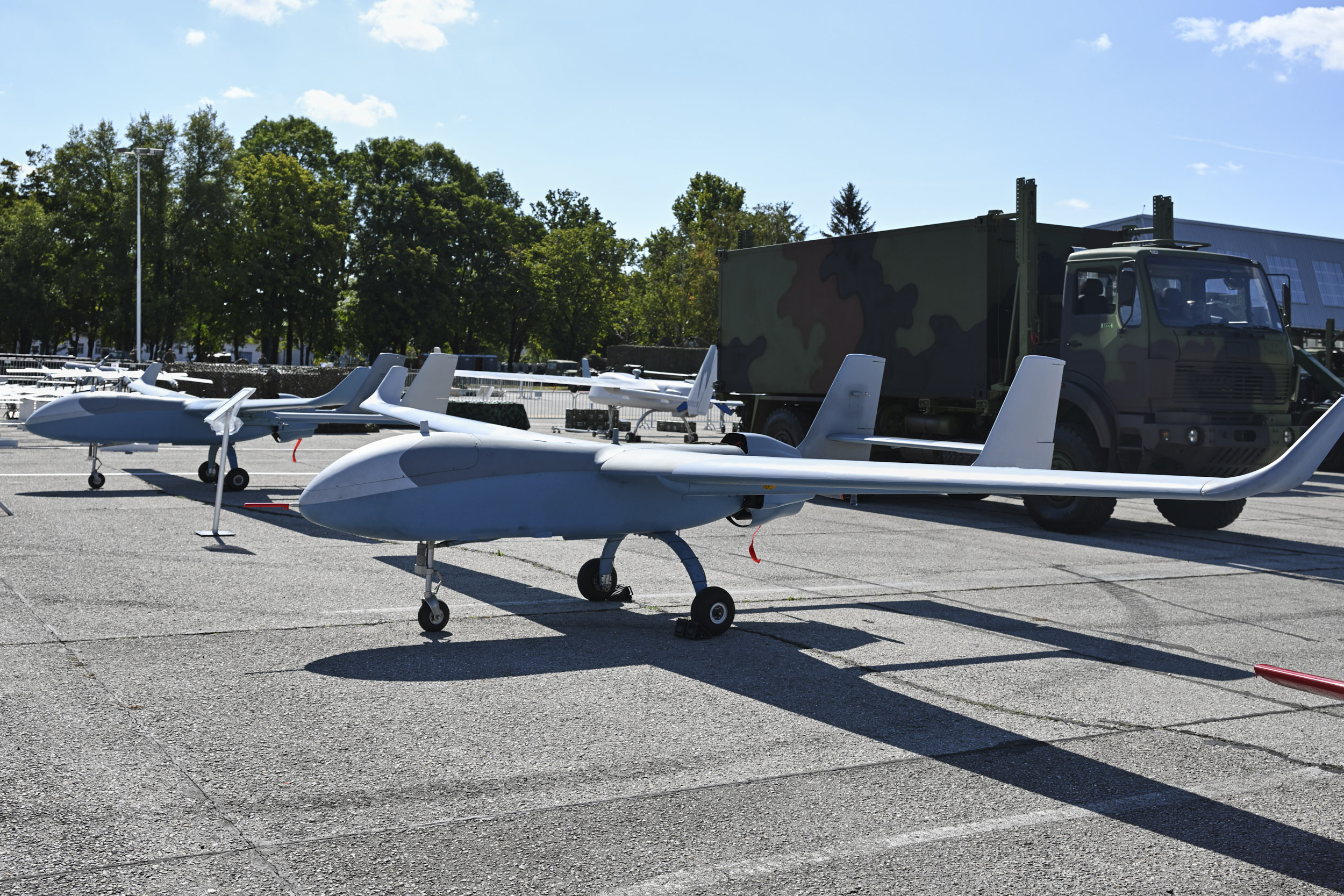
The CH-95 remotely piloted aircraft is a multi-role unmanned aerial system (UAS) designed for aerial reconnaissance and air-to-surface fire missions against enemy forces. Equipped with observation systems, it provides data collection on enemy force dispositions, assessment of the effects of friendly fire, artillery fire correction, and general terrain surveillance. Armed with missiles, it enables effective engagement of ground targets, including armoured vehicles, as well as other stationary and moving targets. Based on its characteristics, it is classified as a medium-range UAV.
CH-92A UAS
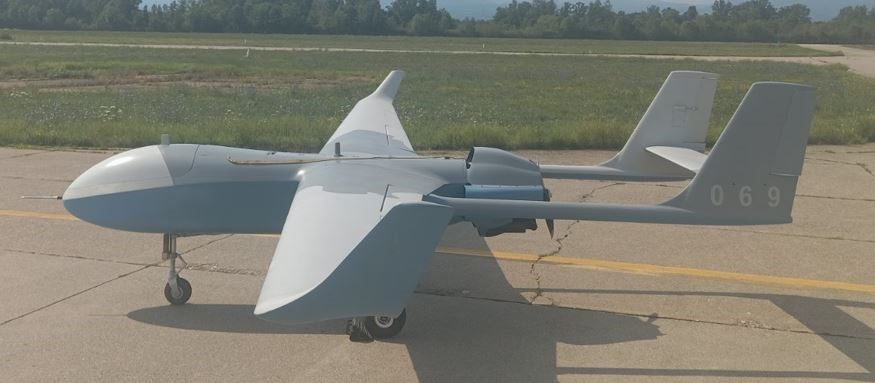 The CH-92A remotely piloted aircraft is a multi-role unmanned aerial system (UAS) designed for aerial reconnaissance and action against enemy forces. Equipped with observation systems, it enables the collection of data on enemy force positions, assessment of the effects of friendly strikes, artillery fire correction, laser target designation, and general terrain surveillance. Armed with missiles, it provides effective engagement of ground targets, including armoured vehicles and other stationary or moving targets. Based on its characteristics, it falls into the category of medium-range UAVs.
The CH-92A remotely piloted aircraft is a multi-role unmanned aerial system (UAS) designed for aerial reconnaissance and action against enemy forces. Equipped with observation systems, it enables the collection of data on enemy force positions, assessment of the effects of friendly strikes, artillery fire correction, laser target designation, and general terrain surveillance. Armed with missiles, it provides effective engagement of ground targets, including armoured vehicles and other stationary or moving targets. Based on its characteristics, it falls into the category of medium-range UAVs.“Pegaz”
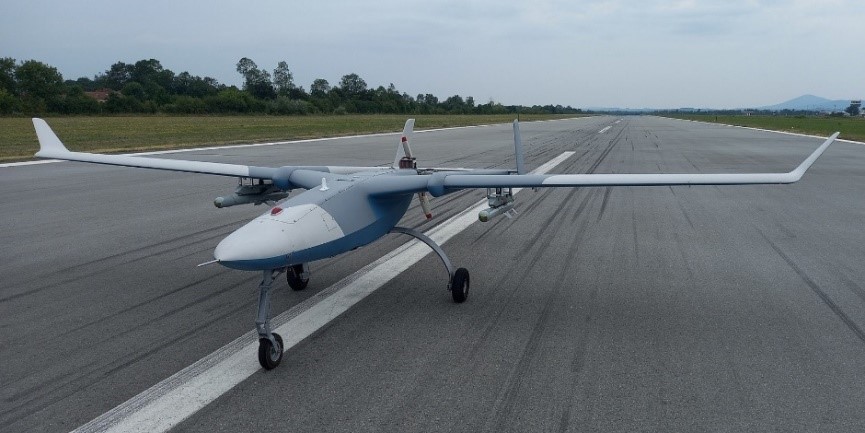
The “Pegaz” remotely piloted aircraft is a medium-range unmanned aerial vehicle (UAV) powered by an internal combustion engine. It is part of a multi-role intelligence, surveillance, and reconnaissance (ISR) UAV system with an operational range of over 200 km and a flight endurance of more than 10 hours.
It is used for intelligence gathering, surveillance, and reconnaissance missions, laser target designation and tracking, artillery fire correction, and battle damage assessment.
The Pegaz UAV can engage ground targets using two precision laser-guided weapons and the RASH-2 system with single-use guided munitions. The guidance system is fully autonomous and includes a “return-to-base” and emergency recovery mode.
"Shadow-25"
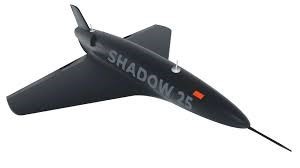 The "Shadow-25" loitering munition system is a medium-range suicide drone designed to engage static, unprotected targets (personnel and equipment) in open areas at distances of up to 250 km. It is armed with a 25 kg warhead.
The "Shadow-25" loitering munition system is a medium-range suicide drone designed to engage static, unprotected targets (personnel and equipment) in open areas at distances of up to 250 km. It is armed with a 25 kg warhead."Shadow-50"
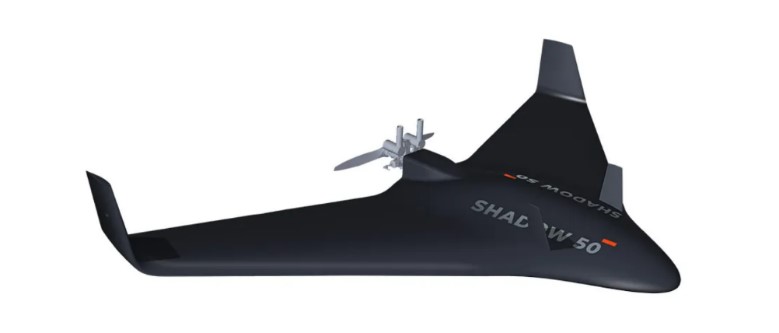
The "Shadow-50" loitering munition system is a medium-range suicide drone designed to engage static, unprotected targets (personnel and equipment) in open areas at distances of up to 300 km. It is armed with a 50 kg warhead.
SM-2
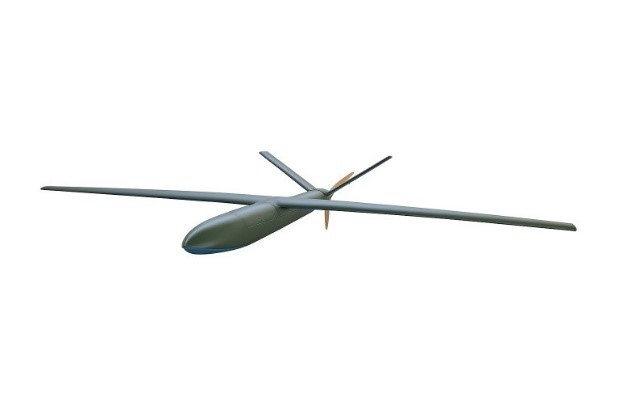
The SM-2 loitering munition system is designed as a modular, relatively lightweight system. The UAV is ground-launched, powered by a two-stroke internal combustion engine, and uses a Global Navigation Satellite System (GNSS) for guidance.
The aircraft can be armed with a warhead for engaging personnel and lightly armoured vehicles. The system’s ground station serves as the mission planning, communication, and flight monitoring centre. It is also used during the preparation phase and for functional checks of the aircraft before being placed on the launcher. The system’s pneumatic launcher is a reliable and robust platform that, in addition to launching SM-2s, can be used to launch other types of UAVs. The launcher is mounted on a trailer towed by a Zastava NTV vehicle. Inside the vehicle, there are operator workstations used for mission planning, system control, and diagnostics. One of the workstations also receives target data provided by the battalion commander or a higher command level. For UAV transport, the system uses a FAP 2228 platform (logistics vehicle). The vehicle carries two containers, each holding eight UAVs for use with two launchers.
“Vrabac”
 The “Vrabac” short-range unmanned aerial vehicle is domestically produced and intended for reconnaissance, monitoring, and observation (of the battlefield, borders, fire detection, surveillance and monitoring of critical roads, power lines, and oil pipelines) from the air, at both day and night. It features fully autonomous operation, automatic hand-launched take-off, waypoint navigation, circling around designated points, camera-guided flight, parachute and airbag-assisted landing mode, and an emergency landing mode.
The “Vrabac” short-range unmanned aerial vehicle is domestically produced and intended for reconnaissance, monitoring, and observation (of the battlefield, borders, fire detection, surveillance and monitoring of critical roads, power lines, and oil pipelines) from the air, at both day and night. It features fully autonomous operation, automatic hand-launched take-off, waypoint navigation, circling around designated points, camera-guided flight, parachute and airbag-assisted landing mode, and an emergency landing mode.IKA-20
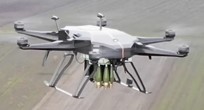
The IKA-20 is a combat and reconnaissance unmanned aerial vehicle (UAV), independently designed and produced by the company PR-DC, in a hexacopter configuration (an aircraft with six rotors). The airframe is constructed from composite materials, primarily carbon fibre and epoxy resin. The flight can be fully autonomous, and the UAV can carry up to 12 aerial bombs with a diameter of 60 mm (such as the Krušik M73 mine with a drone fuse), which it releases with precision to neutralize various targets, during both day and night. After releasing its payload, the UAV can continue its mission in a reconnaissance role by transmitting data to the rest of the system, as it is equipped with the necessary sensors. Other types of weaponry or subsystems that can be integrated into the aircraft include four armed multirotors of the “Komarac-2” type or the 90 mm M79 “Osa” handheld grenade launcher.
“Komarac 2”
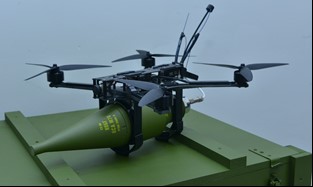
The “Komarac 2” remotely piloted multirotor combat UAV is a single-use FPV drone. It is armed with a 90 mm calibre cumulative-fragmentation warhead OSA M79. It is designed to engage armoured vehicles, lightly fortified targets, and personnel. The drone is manually guided to the target using a control station, with the operator receiving a live first-person view video feed from the drone’s camera. The warhead is coated with small steel balls to increase effectiveness against personnel and lightly fortified targets. The warhead’s fuse can be activated either upon impact with the target or manually at a desired moment during flight. When the fuse is triggered, the warhead strikes the armoured target with a shaped charge jet, penetrating it, while simultaneously dispersing steel balls radially, damaging everything in close proximity. The fuse includes several safety mechanisms (arming delay, transport safety lock, etc.) and can be fitted to most commercial drones.
 PHOTOGALLERY
PHOTOGALLERY
